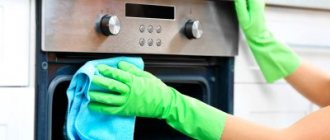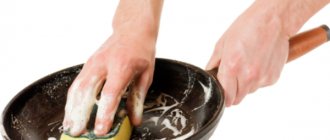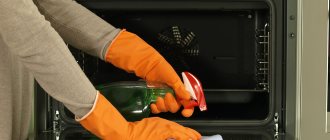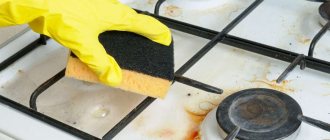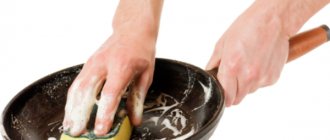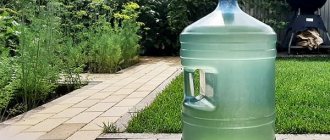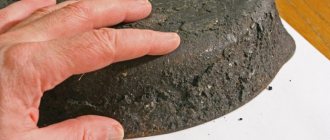The deliciously crispy, golden crust of the meat and the dizzying aroma of vegetables baked in the oven will leave few people indifferent. It is rare that cooking in the oven is complete without oil splashing and soot settling on the inner walls of the kitchen appliances.
Washing a device is a tedious procedure, however, thanks to the use of some available tools, it is quite possible to turn cleaning into a process that requires minimal effort and time.
Security measures
Many chemical detergents contain aggressive substances that, when they evaporate or get on the skin of the hands, can cause an allergic reaction and burns.
Even harmless, at first glance, home remedies - citric acid, soda - also negatively affect the skin and mucous membranes upon direct contact with them, causing various irritations and peeling.
Vinegar is a wonderful cleaning product , however, if you decide to use this product to wash surfaces, also be careful - the acid it contains can cause skin burns.
Therefore, when starting to clean the oven, be sure to wear rubber gloves (remove all jewelry first) and while working, make sure that the product you use does not get into your eyes.
IMPORTANT! If the detergent comes into contact with the skin or mucous membranes of the organs of vision, immediately rinse your hands or eyes with plenty of clean water.
To ensure that during operation you have free access to all internal surfaces of the device, before carrying out the procedure, remove all racks from the oven, remove dishes and baking sheets.
Find out how to clean a gas oven - 13 recipes for use at home.
Reviews from people
Maria, 45 years old
I had no idea that sodium bicarbonate is another name for regular baking soda. I always use kitchen products to clean the oven. It washes off perfectly, why bother with chemicals from the store?
Nadezhda, 26 years old
I recently got married, my husband loves all sorts of baked things. I learned to cook, but the oven fell into disrepair. I wanted to buy a new stove; I didn’t believe it could be cleaned. Thank you very much for the simple recipes.
Vasily, 40 years old
As a chef in my own small cafe, I confirm that it is much more economical and convenient to use homemade recipes. I teach my employees recipes for detergents; for many it turned out to be a revelation. I don’t understand why the industry doesn’t produce using home remedies?
Nina, 32 years old
My child has allergies, so I don’t use industrial chemicals. I suffered with shampoos, detergents, and soaps. My husband, a chemist by profession, told me to wash the kitchen with NaHCO3. The doctor approved it, it turned out that this is a hypoallergenic product. Many problems have gone away, allergic manifestations have decreased.
Soda, vinegar, salt
The simultaneous exposure of three foods can quickly remove old grease deposits from the walls of the baking cabinet.
To enhance the cleaning effect, use vinegar essence (70-80% concentrated acid solution) instead of table vinegar:
- moisten the walls of the oven, soak a sponge in water, put soda on it and apply the powder to the internal surfaces of the device;
- pour 500 ml of water (room temperature) into a heat-resistant container, add 350 g of table salt and add a tablespoon of vinegar essence, stir all components of the solution thoroughly until they are completely dissolved;
- turn on the oven, set the heating temperature to 180-200 ⁰C;
- place the dishes with the prepared product on the bottom or lower tier of a heated kitchen appliance for half an hour;
- turn off the baking cabinet, let it cool for 20-30 minutes;
- open the device door, remove the container with the solution;
- Using a soft sponge, thoroughly wipe all the walls of the cabinet, starting from the top, then wash the sides and bottom;
- Rinse the internal parts of the device with clean water and leave the oven door open for a while to allow the stove to dry.
REFERENCE! If the stove is only slightly dirty, you can use a simpler cleaning option: sprinkle coarse table salt in an even layer on the bottom of the cabinet, turn on the oven (up to 100 ⁰C).
After 30-40 minutes, the salt will acquire a light brown tint - turn off the gas (power supply), let the chamber cool and remove greasy deposits from the walls with warm soapy water.
Will you use the suggested recipes?
Not really
Steam treatment
Housewives prefer this method. It is recognized as the most effective, less difficult and the cheapest.
Steam treatment technology involves simple steps:
- Pour 2 liters of water into a large and wide saucepan.
- Turn on the electric oven at 220 degrees.
- Place a pan of water on the bottom of the oven.
- Leave for 35 - 40 minutes so that the steam softens the dirt.
- Turn off the oven and wait until it cools down to a comfortable operating temperature.
- Use a sponge dipped in soapy water to wash all areas of the compartment.
- Then go over with a clean damp cloth and wipe with a rag.
It is possible that if the contamination is severe, the procedure will need to be repeated.
The advantage of the method is safety, efficiency and lack of cost. If all the water has evaporated during the processing process, then you need to top it up so as not to spoil the pan and not to dry out the softened fat again.
Soda, vinegar and citric acid
An unpleasant odor often “settles” in a dirty oven , which is felt every time the oven door is opened.
To clean kitchen appliances and, at the same time, easily get rid of the second problem - the “aroma” of ingrained fat and soot - you will need soda, apple cider vinegar and citric acid.
Sequence of the procedure:
- turn on the oven (set the heating temperature to 100 ⁰C);
- While the device is warming up, pour half a glass (100 ml) of apple cider vinegar into a small bowl, add 40-50 g of citric acid and 1 tablespoon of soda powder, mix everything;
- turn off the device, treat the hot inner walls of the chamber with the prepared preparation;
- close the door of the device, leaving the product to act on the surface for 20 minutes;
- after the time has passed, soak the sponge in water and wipe the treated oven walls, then rinse them with clean water;
- After cleaning, leave the cabinet to dry with the door open for half an hour.
IMPORTANT! If apple cider vinegar is unavailable, you can replace this ingredient with regular table vinegar. Similarly, fresh juice of 1 lemon is suitable as an equivalent replacement for citric acid.
Citric acid does an excellent job of cleaning the iron inside and out; read more about this here.
Cleaning with vinegar, baking soda and soap
A paste made from soda and dishwashing detergent perfectly removes grease and fumes from the walls of the chamber. To make such a product, mix soda powder and a chemical in equal proportions, apply it with a sponge to the walls and, after 20-30 minutes, wipe off the dirt.
When removing plaque, act extremely carefully, without applying too much force. Otherwise, the walls of the device may be scratched.
There is also a second, simpler option for the cleaning procedure, which involves the use of these products:
- moisten the walls of the chamber (wet them with a sponge or spray water from a spray bottle);
- dip a rag in water, wring it out lightly, sprinkle soda on it;
- Apply the powder to damp surfaces and leave the device like this for an hour;
- Apply liquid detergent to a sponge and wash the oven, then wipe clean surfaces several times with water and dry with paper towels.
ATTENTION! If the cabinet walls are very dirty, “help” the soda to dissolve the grease deposits using table vinegar: pour the vinegar into a container with a spray bottle and, after treating the surfaces with soda, spray an acidic product on them.
Steam cleaning method
Steam helps soften plaque, making it much easier and faster to remove dirt. The steam generator allows you to easily remove grease and fumes.
But, if you don’t have such a device, you can arrange a steam “bath” for the stove in other ways:
- pour a liter of water into a fireproof container;
- add any cleaning agent that you use to wash dishes to the liquid;
- place the solution in the cabinet chamber, turn it on to warm up to 140 ⁰C;
- After 45 minutes, turn off the oven and wash off soft stains with a sponge and detergent (you can use laundry soap).
In addition to detergent, vinegar essence can be an ingredient for a steam bath:
- preheat the oven to 200 ⁰C;
- pour a liter of water into a baking tray or other container, add 2 teaspoons of essence to it;
- put the dishes in the oven;
- after the liquid boils, note the time: after 15-20 minutes, when the device door begins to fog up, turn off the device;
- After half an hour, when the stove has cooled down, open its door, wipe all internal surfaces with a damp cloth, then with a dry towel.
Recipe 3. Special product
How to clean the oven with special products?
When home recipes do not help to effectively clean the oven, try special products: Amway, Schumanit and others. For example, housewives like Amway because it has no smell, can be used economically, and the set includes a brush that makes cleaning the oven easier. Faberlic impresses with its price, but you shouldn’t expect it to be enough for a large number of cleanings. And Shumanit has a convenient form - a spray, it is quite pleasant in price, but with a pungent odor.
Ingredients:
- Special tool.
- Water.
Inventory:
- A pair of gloves.
- Rag.
- Sponge.
- Brush.
Procedure:
- Before cleaning a gas or electric oven, remove the oven rack and utensils.
- Clean the oven door and cavity. To do this, apply the product with a brush or small brush. But you should open the window and put on gloves.
- Leave to stand for half an hour.
- Clean the oven from carbon deposits and grease stains with a cloth. Thanks to the product, dirt is easily separated.
- Rinse off any remaining gel with water. If some places are difficult to reach, a spray will help.
- Put the wire rack and utensils back in place. And wash the outside of the oven door.
How to clean a baking tray
The container for baking food gets dirty much faster and more heavily than the walls of the oven itself, so when regularly paying attention to cleaning the oven, do not forget to clean this accessory.
One of the fastest and most effective cleaning methods is to use baking soda, hydrogen peroxide and liquid dish detergent:
- mix 100 g of soda, 1 teaspoon of detergent, 2 tablespoons of peroxide in one container to obtain a homogeneous white mass;
- apply the composition to all surfaces of the baking sheet;
- After 15 minutes, use a hard sponge to clean the deposits from the baking container.
Stubborn carbon deposits can be removed in the following way:
- fill the baking tray with hot water with 2 tablespoons of soda dissolved in it;
- After 3 hours, use a hard sponge to wipe off the plaque from the surfaces.
ATTENTION! To prevent the baking tray from having to be washed frequently, before placing food in it, place parchment paper on its bottom (including the sides).
Special attention is required when washing baking trays made of ceramics, Teflon, enamel and other “delicate” materials, for cleaning which it is unacceptable to use abrasive agents.
Preparations and methods for removing contaminants from the surfaces of such kitchen utensils are presented in the table:
| Means | Mode of application |
| Dishwashing gel |
|
| Mustard powder |
|
| Baking powder for the dough |
|
| Soda and salt |
|
How to prevent the formation of greasy stains and carbon deposits
The best way to clean an oven is prevention. Only regular use of a thick baking sleeve will help reduce the appearance of greasy stains. If cooking by hand is not suitable, you should try to wash the oven with a sponge and dishwashing detergent after each use.
The key to cleanliness is cleaning after each cooking.
Store-bought products will also help to clean the oven; “heavy artillery”, which contains alkali or acids, works best. You can use folk and industrial remedies together, not forgetting that you need to work with gloves.
Useful tips
- daily wiping the inner walls of the baking cabinet with detergent will save you from the need for frequent “general” washing procedures;
- To easily and quickly remove fresh streaks of fat in the chamber, before wiping the surfaces of the device, slightly warm up the kitchen appliances (to a temperature of 40-50 ⁰C) for 20 minutes;
- Before starting work on cleaning the oven, remove (if the design features of the device allow) the door from the oven: this will make cleaning the equipment easier;
- during the cleaning process, avoid contact of any detergents with the heating elements of the device or the fan;
- if, despite the ideal cleanliness of the internal surfaces, there is an unpleasant odor in the oven, crush 15 tablets of activated carbon, mix the powder with a glass of water and place the liquid in the oven overnight, closing the door. Thanks to the absorbent properties of coal, excess “aromas” will disappear.
IMPORTANT! To clean the oven, it is unacceptable to use steel wool, hard sponges, brushes and abrasive detergents - by removing plaque, you can damage the surfaces of the cabinet.
When cleaning the oven, strictly adhere to a certain algorithm of action and observe the proportions of the products required to prepare the cleaning solution.
The number of procedures for removing contaminants can be significantly reduced by using special lids during the baking process that prevent drops of fat from getting on the walls of the chamber.
You will find 12 recipes on how to clean the inside of the oven in this article.
Did you find this post helpful?
Not really
Why do you need regular oven cleaning?
Cooking various dishes in the oven is accompanied by the adhesion of splashes and fat to its inner surface. Additionally, condensation with an odor is formed. Periodically turning the oven on and off leads to repeated melting of chemical compounds. They change the structure, form stains, and are absorbed into the inner surface of the walls. Repeated combustion is accompanied by the release of burning and an unpleasant odor. It literally saturates the oven and dishes. It’s not always pleasant to eat a cake with the smell of fish or chicken baked the day before.
Regular care of the oven and its surfaces will help you avoid problems. It is best to carry out such cleaning after each time you turn on the oven. Removing grease and carbon deposits from recently cooled surfaces is much easier than dealing with old, stubborn stains. This approach will help you forget about unpleasant odors from the oven forever.
Dirty and clean oven
The main problem is the lack of free time. Many people prefer to clean the oven as dirt builds up. If you use your oven frequently, it is recommended to clean it at least monthly.

